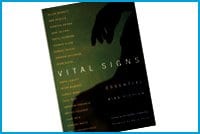Life is an inexorable march toward death. This is a defining aspect of the human condition — but for so many gay men in the late 1980s and early ’90s, the pace sped up considerably. Those who did not find themselves sick were surrounded by dying lovers and friends.
In Vital Signs: Essential AIDS Fiction, editor Richard Canning has assembled a moving evocation of that time, reflecting on the lessons and losses of the era prior to the advent of protease inhibitors and the subsequent generations of potent anti-HIV medications.
That particularly urgent historical moment, Canning argues, birthed the most focused and poignant examples of AIDS literature. Indeed, the nature of the crisis meshed with the structural constraints and dramatic requirements of the short-fiction form — because life with AIDS was frequently a story far too short. The book’s 18 authors consider universal themes — sex and death, love and relationships — with a painful specificity.
The award-winning story “The Final Inning” by Jamaican-American Thomas Glaves reveals how death can force clashes of culture and sensibility. Characterized by vivid stream-of-consciousness prose, the story digs through the aftermath of a funeral-home riot that ensues when ACT UP members crash the funeral of Duane, an African-American gay man whose family struggles to acknowledge his cause of death.
Vital Signs does not shy away from the erotic and its shifting implications. In “Workload,” Robert Glück’s narrator muses about the men populating his masturbatory material. Checking the date on a porn magazine depicting pre-condom sex, he notes, “These orgasms were in 1985… I could be jerking off to a man contracting HIV.” Given the resurgence of condomless porn and a UK incident last September where three young actors acquired HIV during an unprotected sex scene, the story still resonates today.
Several contributors with AIDS point out the absurdity of their situations to comic effect. In an excerpt from his autobiographical novel Spontaneous Combustion, David Feinberg captures the tenor of gay media at the time with arch wit — particularly the conspiracy-minded New York Native — in addressing various proposed causes of AIDS: the “tertiary syphilis theory” versus the “track lighting and industrial gay carpeting and quiche theory.”
But there are limits to the laughter. The piece ends jarringly with a spontaneous nosebleed in a coffee shop: “All I could think of was the virus that was coursing through my blood. I blotted it out with the napkin and sat there ashamed, frightened, in despair.”
Apocalyptic visionary David Wojnarowicz blends surreal humour with intense despair in “Spiral”. After a hallucinatory scene involving Whitney Houston and the anus of Iran-Contra schemer Oliver North, the narrator sticks his head out a window, screaming to the empty streets below: “There is something in my blood and it’s trying to fucking kill me!” (Check out the website of ACT UP New York at Actupny.org to hear a stirring reading of this startling piece.)
Canning, a literature prof at Sheffield University in the UK, introduces the book with a comprehensive essay that covers many more stories than are in the volume. His contributors have two kinds of biographies. Some, like poet and novelist Glück, noted lesbian writer Rebecca Brown and literary stalwart Edmund White (himself living with HIV) have published extensively since these stories were first penned.
Meanwhile Canadian contributor Peter McGehee’s “Fever and Chills” was first published after his death and US author Allen Barnett wrote a single, acclaimed collection of AIDS stories called “The Body and Its Dangers” and then died less than a year later.
The stories in Vital Signs transpire before a shared cultural backdrop and feature common references — Phil Donahue, Ronald Reagan, free trade, apartheid-era South Africa, The Body Politic — illuminating a particular world in which gay men lived and died. Its inhabitants pin their hopes on experimental treatments nearly forgotten today, such as AL 721 (which was made from egg yolks) or DNCB (a fluid normally used to develop photographs).
Because of profound and ongoing treatment advances things look very different now. Gay men still die of AIDS-related causes, yet today one of the fastest growing fields of inquiry is HIV and aging. But the stories in Vital Signs offer an important opportunity to reflect both upon what has changed since they were written as well as what remains the same.

 Why you can trust Xtra
Why you can trust Xtra


